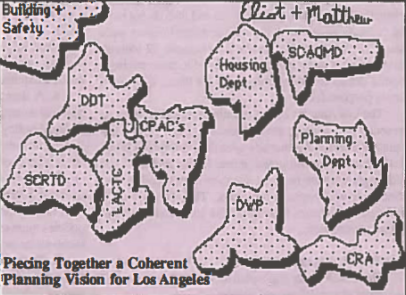At the March 7 luncheon symposium sponsored by The Planning Report on the topic of the Community Redevelopment Agency, the phrase most often heard was: “the need for a vision.” One after another on the panel — including Councilmember Zev Yaroslavsky, lawyer Dan Garcia, CRA board member Carlyle Hall, Lincoln Property’s Mike Sondermann and Central City Association President Jim Hunter — emphasized the need for the CRA to redefine its mission, regain its focus and achieve a coherent vision of its future role in Los Angeles’ development. Leon Whiteson, an architecture critic for the Los Angeles Times and a Contributing Editor of The Planning Report, shares the panel's responses here.
The Stealth Agency
“The character of the agency is changing,” Hunter said. “The former emphasis on the commercial development of the Central Business District is evolving into a broader and more complex role.”
Hall agreed that the CRA has failed to articulate its mission, appearing so unfocused that many call it “the Stealth Agency.” “It can be accused of a certain lack of candor,” Hall admitted, criticizing the CRA for its obsession with secretive deal-making.
Yaroslavsky was considerably less polite. “The CRA is bloated and misdirected,” he declared. “In fact, we might ask ourselves if we need it any more, if the moneys it appropriates from its tax-increment privileges are really well used, particularly in a time of budget crisis.” As an example of the agency’s “bungling,” Yaroslavsky cited the ill-fated housing development at Franklin-La Brea in Hollywood, where the CRA failed to meet deadlines for federal funds. “At the very least, the CRA needs a real change of leadership, especially after the recent debacle with (former Administrator) John Tuite.”
The Politics of Redevelopment
Since the role of the CRA is inherently political, the perception of its responsiveness to public priorities is crucial. “Presently, the perception is that the agency is not a teamplayer,” said Garcia. “There is a widespread suspicion about its priorities from a broad spectrum of interests and opinions.”
While several panelists urged the CRA to repair its critical relationship with the City Council, which now exercises more oversight over the agency, Yaroslavsky warned that simply replacing Tuite with Acting Administrator Ed Avila would not remedy some basic conflicts. “Ed’s a nice guy, and we all respect him, but getting along with the Council should not be the CRA’s main concern.” Even some friction between the two could be fruitful, if it came about over real issues.
Several panelists criticized the CRA for its bureaucratic inefficiency and general unresponsiveness, evidenced in its seeming inability to create an effective policy for affordable housing.
The staff is confused and often obstructionist, several panelists observed. Sondermann, who has dealt repeatedly with the CRA over development projects, bluntly characterized the agency as “reactionary.”
Conflicting Directions
Garcia commented that the current condition of the CRA is a symptom of the general lack of consensus about the city’s direction. In this confusion, the CRA has concentrated on making deals to the exclusion of any real policy. “This floating crap game must end," he said forcefully.
Hunter observed a conflict within the Agency between the CRA staff and the Agency board. Hall agreed and pointed to the Agency's failure to revitalize Spring Street or create a viable residential community in South Park as a result of this lack of common purpose within the CRA itself.
The Planning Report’s publisher, David Abel, asked whether the Council’s new detailed oversight powers over the agency’s operations would simply complicate the process by adding another layer of bureaucracy.
“We aren’t thrilled with the present oversight package,” Yaroslavsky replied. “But it does ensure that the CRA will, finally, become a city agency.”
In theory, the Planning Department is supposed to develop large-scale plans for Los Angeles, while the CRA’s role should be to implement such plans. However, in the context of the paralysis within the Planning Department, and its vulnerability to political pressure from each of the fifteen Council members, the CRA has in fact been more of a planning agency than the Planning Department itself.
The Central Business District and the proposed Hollywood redevelopment project are the prime examples of the CRA’s de facto planning role. In this context, if the CRA is brought to heel, will the last vestiges of large scale planning vanish from Los Angeles?
The answer to this was confused. Hall worried that the CRA was still obsessed with the idea that ‘big is beautiful’ in its planning strategies.
Lobbyist Art Snyder worried that the CRA might “change from one wrong direction to another,” by discouraging downtown development, and noted that commercial development in the Central Business District is seen as a ‘milk cow’ for everything from affordable housing to art programs.
While Yaroslavsky insisted on the need to plan for affordable housing downtown, Snyder worried the area could become “a concentration camp for poor people.”
Respondents' Comments
Summing up, Gerry Hertzberg, aide to former Councilwoman and current County Supervisor Gloria Molina, emphasized that commercial and residential development were interdependent. The city needs to create socially and economically balanced communities, such as the proposed Central City West, Hertzberg said.
Gil Ray of O’Melveny and Myers said that the city needs a CRA, but a CRA that understands its mission in the coming decades. Returning to the symposium’s central issue, Ray said, “We have to ask the vital question whose vision is it?”
- Log in to post comments




